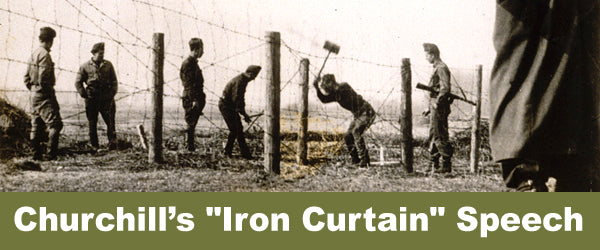
Posted by The Home School in the Woods Team on
By Sam Pak
It’s the time of year that we revisit an influential speech delivered by an iconic figure! That’s right, we’re taking a look at the Iron Curtain speech by Winston Churchill, given to encourage westerners to stay vigilant and to reveal the looming tyranny that was brewing in eastern Europe.
Almost immediately proceeding the conclusion of World War II, the western and eastern powers of the world were embroiled in a new conflict. It was an intense political contrast between the Soviet Union and the countries that would go on to form NATO. The U.S.S.R. saw and seized the ripe opportunity to reform the political landscape in the aftermath of Germany’s surrender.
The speech given by Churchill would mark a pivotal moment of harsh realization by millions of people. It was both eye-opening and encouraging as the world prepared to face a new type of threat that would inevitably collide with western thought.
What Is “The Iron Curtain”?
The term “Iron Curtain” was used to describe the complex series of political agendas imposed by Soviet Russia. It popularized Communism as the obligatory single-party system for the U.S.S.R. and surrounding ally countries.
The term was also intended to illustrate the hidden and protective nature of Soviet idealogy and the effort to prevent western cultures from accessing or influencing their doctrines.
It was a stringent set of rules, including censorship, compliance with the state, and the exclusion of other countries unaffiliated with communism, that made the Kremlin so impermeable.
The U.S. and Britain saw through this, however, which is what prompted them to bear down with heightened caution and proactivity to quell the roots of dictatorial oppression.
We were given a sense of geographic imagery and impact through this famous passage from Churchill’s Iron Curtain speech: “From Stettin in the Baltic to Trieste in the Adriatic, an iron curtain has descended across the Continent.”
What It Meant for the World
When we think about the relationship the U.S. and Britain had with Russia before Germany betrayed them, there was already substantial cause for discomfort. The non-aggression pact established in 1940 that Russia held with Germany was a hint to the Allied powers that Soviet thinking was not too far out of line with Nazi agendas.
In that sense, they were not so incohesive that the countries had cause to act in opposition to one another – or so the Russians thought.
As we know, Germany would go on to betray Russia, serving as the primary motivation that inspired the Soviet Union to join the war against Germany as the third great Allied power.
It was only our common enemy during the war that united the Soviet Union with the West, as is later evidenced by Churchill’s Iron Curtain speech.
The Allied powers managed to temporarily contain their disagreements in an effort to concentrate on putting down the Nazi regime. Once the dust from the war began to settle, it would only be six months later, on March 5th, 1946, that Winston Churchill would famously deliver his Iron Curtain speech at Westminster College in Fulton, Missouri. The aim was to reveal the harsh reality of Soviet communism manifesting in the wake of the war, now that the Axis powers had been dissolved.
As for Russia, they naturally perceived the speech as an act of war-mongering and provocation. It was enough to convince Russia that they needed to brace for the impact as the world would soon come knocking at their door, looking for answers — answers they were none too keen to give.
Upon learning that NATO was formed in preparation for a potential war, the Soviet Union followed suit by forming the Warsaw Pact, bearing similar implications of mutual protection and reciprocation to acts of aggression.
Churchill’s Urgent Plea
Although the speech was well received, it was certainly controversial at the time. Churchill was past his time as Prime Minister and therefore held less authority. But it did not stop him from making his speech, which he deemed crucial for the U.S. to hear.
Disguised in well-constructed rhetoric and thought was an urgent plea for participation in combating the Soviet hive mind. He anticipated the path the U.S.S.R. would take and needed to foster help before the U.S. pulled out.
The world was tired from warring with Germany for close to seven years, and many were eager to rest and heal. Churchill’s speech was a success in the fact that he stirred the United Nations to maintain continuous awareness, caution, and intolerance of Communism.
A Realigned West
Churchill delivered his speech masterfully, inspiring hundreds of thousands of men and women in England and the U.S. He was unafraid of the looming threat now facing the world. The speech would become one of the first gestures to acknowledge and foreshadow an imminent new conflict, a war that would become known as the Cold War.
You can learn more about important players and events that stemmed from Churchill’s speech in our Napoleon to Now Timeline Figures set, which includes figures like Winston Churchill, the Cold War, and Joseph Stalin. You can find other participants and events in our America’s History Timeline Figures set! And for lessons and activities on WWII in general, check out the Time Travelers: World War II.
